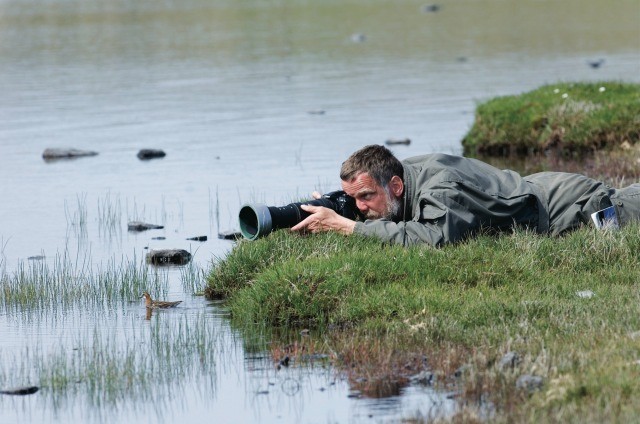The interest in bird photography has boomed over the past decade. Many birdwatchers have become keen photographers, regularly carrying a camera when out birding, whether it be a conventional camera and lens or a compact camera for digiscoping. So it is probably safe to say that most people who go birding are photographers to some degree or other.
With so many more people wanting to photograph birds, particularly rarities, there are added pressures and responsibilities on photographers. It is usually necessary to get close or sit it out in hides on reserves but all this can bring us into conflict with others. Based on an admittedly non-scientific sample, it seems that many of the complaints about birders' behaviour these days, especially where rare or scarce migrants are concerned, are directed at people trying to photograph the bird. For many years, wildlife photographers affiliated to photographic societies, clubs and organisations have worked with a code of practice. The following list is as much advice to new and aspiring photographers as it is a guide to good ethics and ensuring that the photographer stays within the law. It is time that birders had a Bird Photography Code of Practice and I hope that these recommendations will act as a useful reference for bird photographers at large in Britain and elsewhere.
- A well-used mantra but one that is paramount is that the welfare of the bird is more important than the photograph.
- Birds should not be harassed by continual pushing and flushing. Most rarities soon settle into a pattern and successful photography can often be achieved by waiting patiently and allowing the bird to come to you.
- The use of playback vocalisations should be employed sparingly, if at all; if a reaction is not forthcoming immediately, then playback is unlikely to work and should not be repeated in a given territory. It should be noted that the use of playback for species protected under Schedule 1 of the Wildlife & Countryside Act may be considered illegal.
- Photographing breeding species listed under Schedule 1 of the Wildlife and Countryside Act requires a licence. It is an offence to recklessly disturb a Schedule 1 species when that species is nest-building, at, near or in a nest containing eggs or young. This includes the photography of dependent young, too. In recent years in Scotland, photographing lekking Capercaillies has also become illegal without a licence. Note that this includes 'rogue males' during the lekking season. The Forestry Commission has issued a directive not to conduct any activities within 500 m of known Capercaillie leks during March, April and May. To apply for a licence to photograph Schedule 1 species you need to contact the respective licensing bodies. In the UK these are Natural England, Scottish Natural Heritage, the Countryside Council for Wales and the Northern Ireland Environment Agency.
- Photography at or near a nest should be undertaken only by those with a good understanding of the species involved and who are, therefore, able to keep disturbance to a minimum. If photography is likely to inhibit normal behaviour, a hide should be used and moved slowly into position; normal practice is for a hide to be moved a short distance each day. A competent bird photographer will be able to identify whether the birds have accepted the hide and this should be checked after every move. If the birds show signs of rejecting the hide, it should be moved back to its previous position. If signs of rejection persist, photography should be abandoned. Good hide etiquette requires the photographer to be seen into the hide by another person and duly collected. Hides used for nest photography should not be left erected at sites that might attract public attention.
- Vegetation, whether around a nest or in other circumstances, for example concealing a shrike's larder, should not be chopped away; judicious gardening, including the tying back of branches, is acceptable, as long as the habitat can be returned to the state in which it was found.
- Live mammals such as mice should never be used to bait predatory birds such as raptors and owls.
- Always ensure you have the landowner's permission if you are venturing into an area away from public rights of way or common land.
- Nesting colonies, roosts and important feeding areas should not be disturbed in pursuit of photographs. The thoughtless actions of one photographer can jeopardise the reputation of others.
- Respect the rights of fellow photographers. If a photographer is in a position close to a bird, resist the urge to immediately join him or her without first gaining their acceptance. A photographer may have taken a considerable amount of time to carefully approach a bird and by assuming it is fine to approach you run the risk of both flushing the bird and making yourself unpopular with your fellow photographer.
- Be honest in declaring the circumstances in which a picture has been taken; if it is of a captive bird, then that should be stated in your caption, particularly if publication or public display is intended.
- If digital manipulation is used, in other words a material change to the subject matter, such as an extra bird added to (or removed from) the picture, a background change or other major cosmetic alteration, then this should be stated to avoid misleading the viewer and misrepresenting the subject.

Be considerate to other photographers, who may have made considerable efforts to get into a good position to photograph the bird, here a Red-necked Phalarope Phalaropus lobatus at a feeding loch on Fetlar, Shetland, June 2006. (Photo: David Tipling.)
Acknowledgments
I would like to thank Robin Chittenden, David Hosking and Dave Kjaer for their useful comments and advice while compiling these notes.
This article originally appeared in the April edition of British Birds, and is reproduced here with the kind permission of the author and editor.


